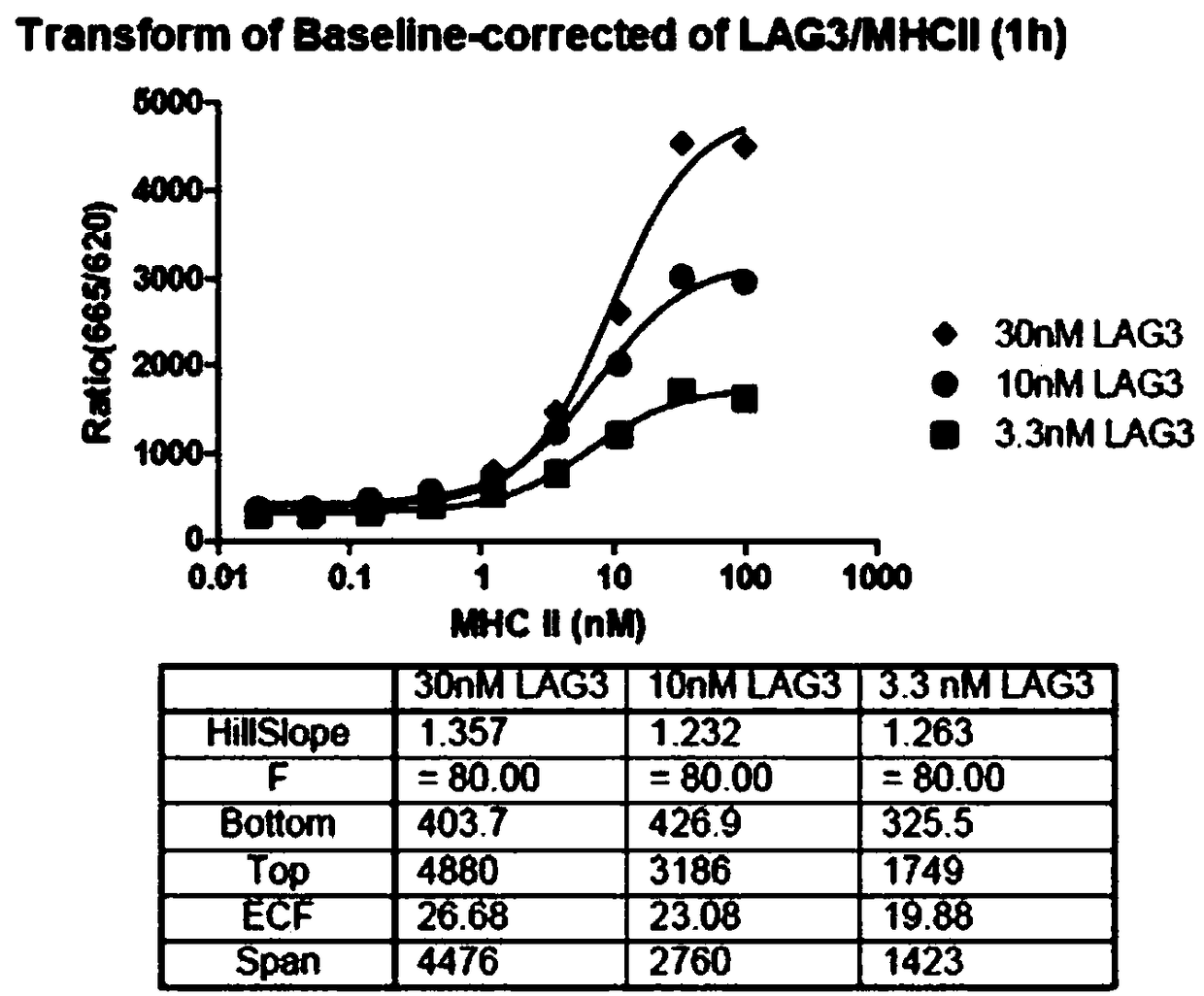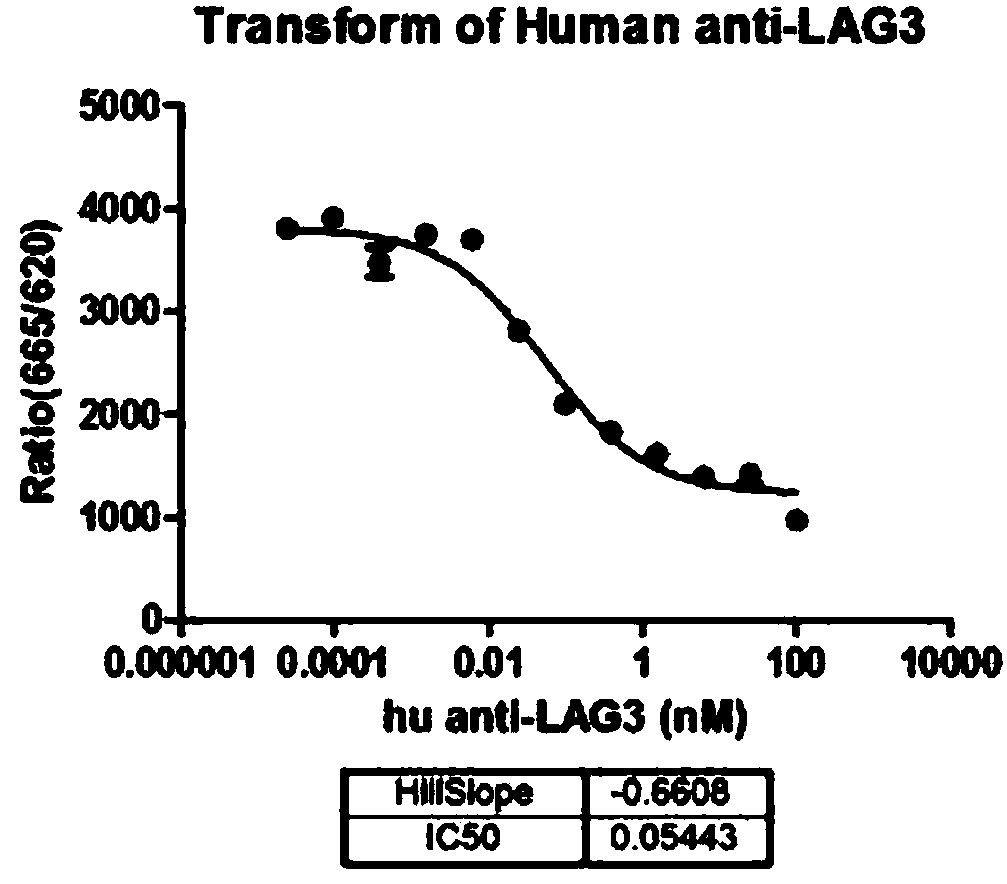Method of using HTRF to screen LAG3/MHCII inhibitor at high throughput
An inhibitor and high-throughput technology, applied in the direction of biological testing, material inspection products, etc., can solve the problems that are difficult to solve due to the large number of samples in drug screening, the inability to achieve high throughput, and poor repeatability of results, so as to save experimental workload and fluorescence Long lasting effect with low false negative rate
- Summary
- Abstract
- Description
- Claims
- Application Information
AI Technical Summary
Problems solved by technology
Method used
Image
Examples
Embodiment 1
[0031] 1) For protein preparation, LAG3 was serially diluted 3-fold from 30nM to obtain 30nM, 10nM, 3.3nM and 0nM respectively; MHCII was serially diluted 3-fold from 100nM to 0.02nM.
[0032] 2) Add 5ul each of the prepared proteins into a 384-well detection plate, incubate at room temperature for 15 minutes, add the tag antibody coupled to Donor and Acceptor (or add 10ul after equal volume mixing), incubate for 1 hour and read.
[0033] According to the principle of HTRF method, detect the fluorescence ratio of 665nm / 620nm, according to this ratio, judge the binding of protein, the higher the signal, the more binding, see the results figure 2 .
Embodiment 2
[0035] 1) Configure inhibitors, and serially dilute the humanized positive monoclonal antibody anti-LAG3blocking antibody of BMS, starting from 100nM, dilute 4 times to 0.00002nM;
[0036] 2) Prepare the protein, and perform follow-up inhibitor screening according to the appropriate protein concentration of Example 1, LAG3 is 10nM, and MHCII is 20nM;
[0037] 3) The prepared inhibitor and protein were added to the 384-well detection plate in sequence, and after incubating at room temperature for 15 minutes, the tag antibody conjugated with Donor and Acceptor was added (or 10ul was added after equal volume mixing). Incubate for 1 hr and read.
[0038] According to the principle of HTRF method, detect the fluorescence ratio of 665nm / 620nm, according to this ratio, judge the binding of protein, the higher the signal, the more binding, see the results image 3 .
Embodiment 3
[0040] The mouse monoclonal antibody anti-LAG3blocking antibody of Abcam is carried out inhibition curve determination, according to the method of embodiment 2, detects, and the result sees Figure 4 .
[0041] Depend on figure 2, 3, 4, it can be seen that the present invention is applicable to the screening of various LAG3 inhibitors, and the amount of protein is less, and the sensitivity of the method is high. The experiment proves that the screening of LAG3 / MHCII inhibitors by the method of the present invention is simple and feasible.
[0042] In summary, the current main screening methods for LAG3 / MHCII are traditional ELISA and FACS, and most of them are cell experiments, which require complex cell line construction. However, the present invention uses HTRF for screening at the biochemical level for the first time, which solves the problems of cumbersome operation, long time, and low throughput of traditional methods, and realizes low cost, high throughput, high sensi...
PUM
 Login to View More
Login to View More Abstract
Description
Claims
Application Information
 Login to View More
Login to View More - R&D
- Intellectual Property
- Life Sciences
- Materials
- Tech Scout
- Unparalleled Data Quality
- Higher Quality Content
- 60% Fewer Hallucinations
Browse by: Latest US Patents, China's latest patents, Technical Efficacy Thesaurus, Application Domain, Technology Topic, Popular Technical Reports.
© 2025 PatSnap. All rights reserved.Legal|Privacy policy|Modern Slavery Act Transparency Statement|Sitemap|About US| Contact US: help@patsnap.com



